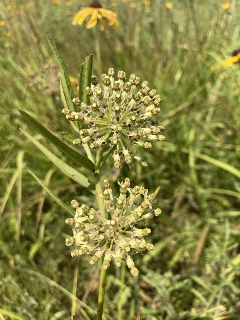 The ANHC relies on a wide network of conservation partners who report important discoveries to us on a regular basis. These partners range from trained amateur naturalists to professional biologists at partner agencies and organizations. Sometimes news of these discoveries arrives in the form of “unknowns” – photos or specimens of unidentified species sent to experts on our staff with a request for an identification. This is how an exciting botanical discovery made its way to us a few weeks ago.
The ANHC relies on a wide network of conservation partners who report important discoveries to us on a regular basis. These partners range from trained amateur naturalists to professional biologists at partner agencies and organizations. Sometimes news of these discoveries arrives in the form of “unknowns” – photos or specimens of unidentified species sent to experts on our staff with a request for an identification. This is how an exciting botanical discovery made its way to us a few weeks ago.In early July I spent a day with Ryan Diener, State Coordinator for Quail Forever (QF). QF works largely on private lands, assisting landowners with habitat restoration and management to benefit not only quail, but a wide variety of native wildlife. Ryan told me about a degraded prairie that they were helping to restore in the Grand Prairie Ecoregion of Lonoke County. The site had been a horse pasture for many decades but had supposedly never been plowed, a claim backed up by a number of remnant prairie plants that he had found hanging on among the pasture grasses that dominated the site. He reported that these plants were now increasing following management practices, consisting of prescribed burning and followed by letting the good plants grow until they make and drop seed. I got excited by some of the plants he mentioned and took him up on his offer to show me the area. Ninety-nine percent of the prairies in this region have been lost, so the discovery of one we didn’t know about, whatever the quality, is good news.
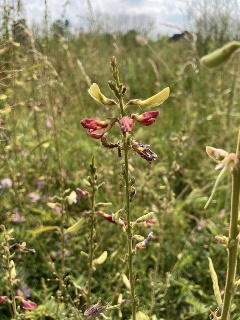 We met QF biologist Alison Menefee at the site and waded off into the grass. In no time we were running into native prairie indicators like tall green milkweed (Asclepias hirtella), large coneflower (Rudbeckia grandiflora), long-bracted wild indigo (Baptisia bracteata), big bluestem (Andropogon gerardi), and Devil’s shoelaces (Tephrosia onobrychoides). There was no question about it, the site had never been plowed and had a lot of potential for restoration, recovery, and discovery. Ryan casually mentioned an interesting vining plant with small pink flowers that they had seen there in one small area a few weeks before and were having trouble identifying. We hunted for it briefly without success and Alison said she’d send me some photos from Ryan Parker, another QF biologist who had first spotted the mystery plant with her and Diener.
We met QF biologist Alison Menefee at the site and waded off into the grass. In no time we were running into native prairie indicators like tall green milkweed (Asclepias hirtella), large coneflower (Rudbeckia grandiflora), long-bracted wild indigo (Baptisia bracteata), big bluestem (Andropogon gerardi), and Devil’s shoelaces (Tephrosia onobrychoides). There was no question about it, the site had never been plowed and had a lot of potential for restoration, recovery, and discovery. Ryan casually mentioned an interesting vining plant with small pink flowers that they had seen there in one small area a few weeks before and were having trouble identifying. We hunted for it briefly without success and Alison said she’d send me some photos from Ryan Parker, another QF biologist who had first spotted the mystery plant with her and Diener.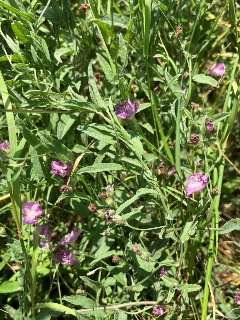 When I received photos later that evening, I had a little trouble believing my eyes. The plant in the photos looked for all the world like water dawnflower (Stylisma aquatica), a rare species of the outer Coastal Plain known in Arkansas today only from a few very rare lowland sand grasslands in and around the Felsenthal National Wildlife Refuge near the Louisiana border in Ashley and Union counties. These habitats occur on linear deposits of deep sand (former beaches of Paleolake Monroe, an ancient inland lake that drained permanently about 5,000 years ago). These areas are very different than the tallgrass prairies of the Grand Prairie, which have a layer of fertile topsoil over a dense clay layer called a hardpan.
When I received photos later that evening, I had a little trouble believing my eyes. The plant in the photos looked for all the world like water dawnflower (Stylisma aquatica), a rare species of the outer Coastal Plain known in Arkansas today only from a few very rare lowland sand grasslands in and around the Felsenthal National Wildlife Refuge near the Louisiana border in Ashley and Union counties. These habitats occur on linear deposits of deep sand (former beaches of Paleolake Monroe, an ancient inland lake that drained permanently about 5,000 years ago). These areas are very different than the tallgrass prairies of the Grand Prairie, which have a layer of fertile topsoil over a dense clay layer called a hardpan. 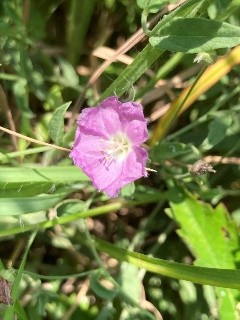 However, the ANHC was aware of an old specimen of the dawnflower in the herbarium at Harvard University that was collected near Ladelle in Drew County back in 1944. The label on this specimen gave the habitat for the plant as “prairie” – and there were tallgrass prairies just east of Ladelle historically (all believed to be gone today). Could the QF biologists actually have discovered the only surviving prairie population of water dawnflower in Arkansas? What’s more, if the plants in the photos were really the dawnflower, not only would this be a new site for a rare species and the only known remaining population in a tallgrass prairie in Arkansas, but it would also be a nice range extension for the species to the northwest and the farthest inland (by more than 90 miles) that the species has ever been documented. But I couldn’t say with 100% certainty from the photos. I’d have to examine an actual plant up close.
However, the ANHC was aware of an old specimen of the dawnflower in the herbarium at Harvard University that was collected near Ladelle in Drew County back in 1944. The label on this specimen gave the habitat for the plant as “prairie” – and there were tallgrass prairies just east of Ladelle historically (all believed to be gone today). Could the QF biologists actually have discovered the only surviving prairie population of water dawnflower in Arkansas? What’s more, if the plants in the photos were really the dawnflower, not only would this be a new site for a rare species and the only known remaining population in a tallgrass prairie in Arkansas, but it would also be a nice range extension for the species to the northwest and the farthest inland (by more than 90 miles) that the species has ever been documented. But I couldn’t say with 100% certainty from the photos. I’d have to examine an actual plant up close.Allison contacted me the next day saying she had relocated the plants, gotten GPS coordinates, and marked them with some flagging tape. I headed out later that day to see the plants in person and sure enough, they checked out. I collected some specimens to document the occurrence and immediately let the QF folks know how important their find was.
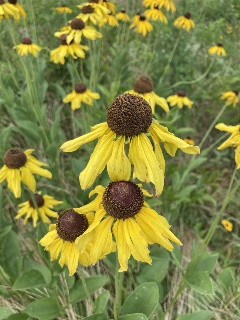 Finds like this, of rare species in remnant natural habitats that are nearly gone from a region, are critical to conservation. Not only are these individual plants or animals rare survivors worth celebrating in their own right, but they can serve as sources of seed or offspring that can be introduced to nearby protected areas that don’t currently support these species (such as several of ANHC’s prairie natural areas a few miles away). Furthermore, populations of the same species from different regions and different habitats are often genetically distinct – specially adapted to specific soil or other environmental conditions where they occur.
Finds like this, of rare species in remnant natural habitats that are nearly gone from a region, are critical to conservation. Not only are these individual plants or animals rare survivors worth celebrating in their own right, but they can serve as sources of seed or offspring that can be introduced to nearby protected areas that don’t currently support these species (such as several of ANHC’s prairie natural areas a few miles away). Furthermore, populations of the same species from different regions and different habitats are often genetically distinct – specially adapted to specific soil or other environmental conditions where they occur. Thanks to our friends at Quail Forever for this important discovery of a new rare species for the Grand Prairie!
Photos:
Photo 1: Tall green milkweed (Asclepias hirtella) at Quail Forever prairie restoration site in the Grand Prairie. The presence of this species is an indicator that the site has never been plowed for agriculture. Photo by Theo Witsell.
Photo 2: Devil's shoelaces (Tephrosia onobrychoides) at Quail Forever prairie restoration site in the Grand Prairie. The presence of this species is an indicator that the site has never been plowed for agriculture. Photo by Theo Witsell.
Photo 3: Water dawnflower (Stylisma aquatica) from newly-discovered population in the Grand Prairie. Photo by Theo Witsell.
Photo 4: Water dawnflower (Stylisma aquatica) from newly-discovered population in the Grand Prairie. Photo by Theo Witsell.
Photo 5: Large coneflower (Rudbeckia grandiflora) at Quail Forever prairie restoration site in the Grand Prairie. The presence of this species is an indicator that the site has never been plowed for agriculture. Photo by Theo Witsell.
